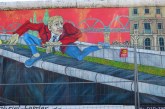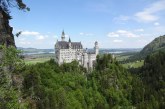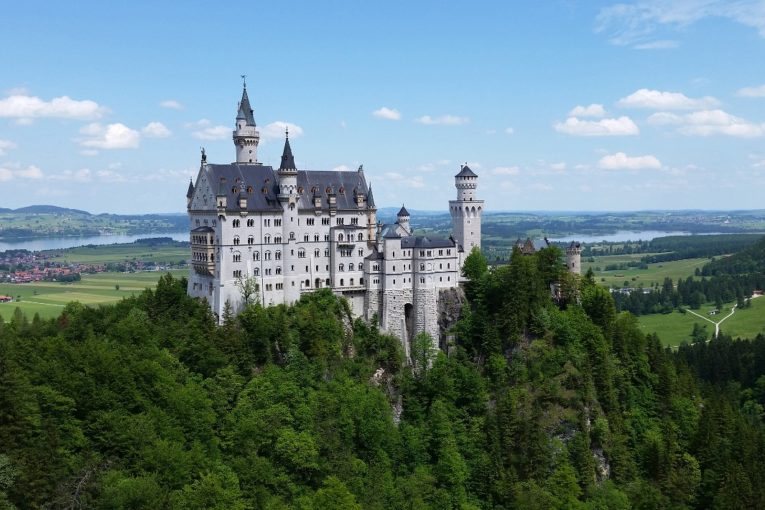
One of the reasons I wanted to come to Bavaria was to see the famous castles of King Ludwig II, the tragically romantic recluse, mad fairy tale king of Bavaria. We toured all of King Ludwig’s castles and one fascinating ruin where he wanted to build. Each castle unveiled more of the fascinating story of the reclusive king.
Herrenchiemsee Palace
About an hour from Salzburg, we visited Herrenchiemsee Palace on the way to Füssen. This enormous palace ended up being my favorite of all King Ludwig’s palaces that we visited, and that’s including the stunning Neuschwanstein. Why was this one my favorite? The palace was meant to be a copy of Versaille and an homage to the reign of the Sun King Louis XIV of France – the finished parts are just over-the-top unbelievable and covered in gold leaf.
A ferry ride across a lake to get there, a 20 minute walk through the grounds, a 45 minute fascinating tour, a museum, and a monastery on the island – all together a terrific visit without the crowds.
Herrenchiemsee Palace Fama Fountain in the background
The fountains flanking each side of the entrance to Herrenchiemsee are fascinating to study.
Fama fountain at Herrenchiemsee
On the Fama fountain the main motif is Fame, with the winged figure fame mounted on the flying horse Pegasus. On the east side of the pyramid of the fountain are the allegories of War, Victory, History and Nature. On the west side are Envy, Hate, and Guile depicted tumbling from the rock.
Herrenchiemsee Palace in honor of the Sun King Louis XIV of France
Herrenchiemsee Apollo fountain
Building, building, always building – the story of mad King Ludwig II of Bavaria and his obsessions are fascinating. Thrust onto the Bavarian throne at the age of 18 at the death of his father, the Bavarian kingdom was lost to Prussia only 2 years later. Ultimately he became a recluse who was obsessed with building monumental castles in homage to the absolute monarchies of France, longing for those times when a King was the all powerful ruler that he was not. Most of his castles remained unfinished but what was finished are just – WOW! The finished rooms in Herrenchiemsee are simply spectacular (no photos allowed).
Tip: If you’re going to visit 3 or more castles like we did while in Bavaria, get the 14 Day Bavarian Castles Pass and save money AND time.
Make time to visit the beautiful Royal Augustinian Monastery (Old Palace) where you can see the surprisingly modest former apartment of Ludwig II and the beautiful baroque Imperial Hall and other interiors. But be forwarned, these beautiful rooms won’t be as impressive after seeing the fabulous interiors of the New Palace!
Royal Augustinian Monastery baroque Imperial Hall
Linderhof Palace
Positively petite compared to King Ludwig’s other palaces, beautiful, small and lavish Linderhof in it’s stunning alpine setting is a pleasure to visit.
Maybe King Ludwig should have kept his building projects small like this one – it’s the only palace that he actually completed, this time his French monarchy obsession paying homage to King Louis XV. For someone who loved building palace after palace, he hated having people around. This was the first palace where he had a lift built for the entire dining room table to descend to the kitchen below to be set and raised again – all to avoid human interaction.
Linderhof entrance
The perfect symmetry of the Italianate pool and terrace garden in front of the Linderhof palace is broken by an enormous 300 year old Linden tree – the original farm in this valley took it’s name, Linderhof, from this tree and King Ludwig kept the name for his opulent palace. Be sure to go up to the Venus temple at the top of the terrace for a magnificent view!
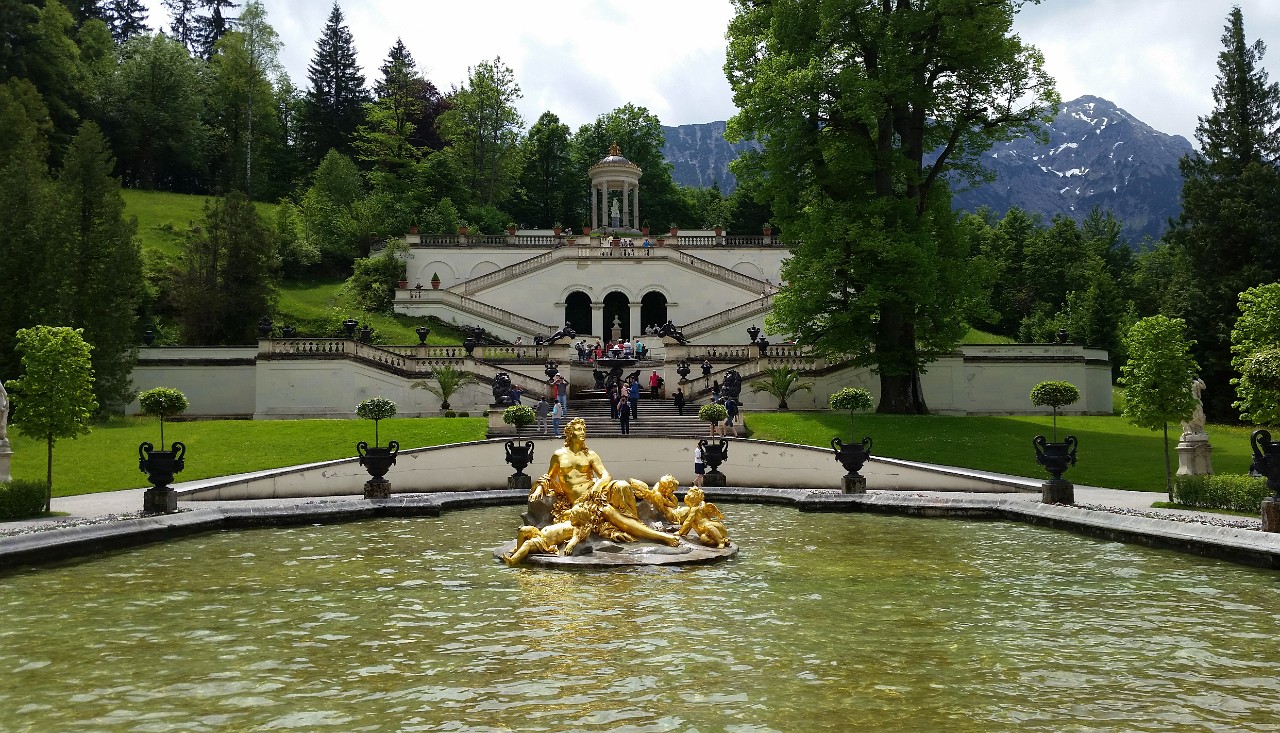
Linderhof Palace gardens and fountain
The guided tour takes about 25 minutes through the Baroque and Rococo rooms of Linderhof. After this tour you’re on your own to make your way to the Venus Grotto for another tour of an amazing one of a kind fantasy.
Linderhof Palace path up to the Venus Grotto
King Ludwig II’s Venus Grotto
Fascinating and artificial, the Venus Grotto at King Ludwig’s Linderhof Palace illustrates another of the King’s obsessions – composer Richard Wagner. Modeled from scenes from Wagner’s opera Tannhauser and complete with waterfall, gilded boat and a stage, the original lights in this dramatic cave were powered by generators in the house some distance away, the first electricity in Bavaria! Just imagine the reclusive king enjoying his beloved Wagner operas…all alone in his gilded swan boat…
Hohenschwangau Castle
Magnificently medieval looking, King Ludwig’s boyhood home Hohenschwangau isn’t medieval at all – but a rebuilding of the original damaged Schwangau Knights castle by King Maximillian II of Bavaria, Ludwig’s father. The fantastic interior is King Maximillian’s concept and covered with scenes of medieval knights and legends painted directly on the walls of the castle, and of course the legend of the swan knight Lohengrin. A wonderful tour, you can tour Hohenschwangau and then Neuschwanstein a couple of hours later as long as you make your tour reservation times well in advance.
Hohenschwangau Castle
Hohenschwangau Castle
Hohenschwangau Knights
Fantasizing of an even more splendid medieval castle than his childhood home, King Ludwig envisioned a “New Hohenschwangau” castle in the style of the old German knights’ castles, watching the progress of the construction through a telescope in the music room at Hohenschwangau.
Neuschwanstein from Hohenschwangau
Our Hohenschwangau tour reservation was for the first tour in the morning at 8:50, followed by a ticket for Neuschwanstein at 10:55. Plenty of time and I highly recommend morning – you’ll have some peaceful time to yourself as you watch the tour crowds roll in.
Neuschwanstein Castle
One of the most visited castles in the world, to say Neuschwanstein is busy may be an understatement, but don’t worry – the Bavarian Palace Department does a terrific, efficient job of managing the crowds. Your entry ticket has the time barcoded on it, you’ll see your tour time on the monitors, queue up and then slide your entry ticket into the reader to enter the tour staging area. You won’t be able to get in outside of your ticket time.
Neuschwanstein entrance
While you’re waiting for your entry time enjoy all the people watching of the selfie obsessed!
The terrace above the ticket entrance has great views of the front of the immense Hall of Neuschwanstein Castle. Inside is the gorgeous Hall of Singers, King Ludwig’s monument to medieval knights and legends, and the King’s Throne Hall and residence rooms, all of which you can see on the tour.
Neuschwanstein exterior frescoes, St. George slaying a dragon on the left
Neuschwanstein exterior details
Only 15 magnificent rooms were ever completed before the King ran out of money and credit, and …time. Fed up, the Bavarian government decided to depose the King, declared him incompetent to rule and forcibly removed him from Neuschwanstein.
After the guided tour through the finished rooms, take a quick detour for magnificent panoramic views of the valley below and Ludwig’s childhood home Hohenschwangau from the open balcony at the back of Neuschwanstein.
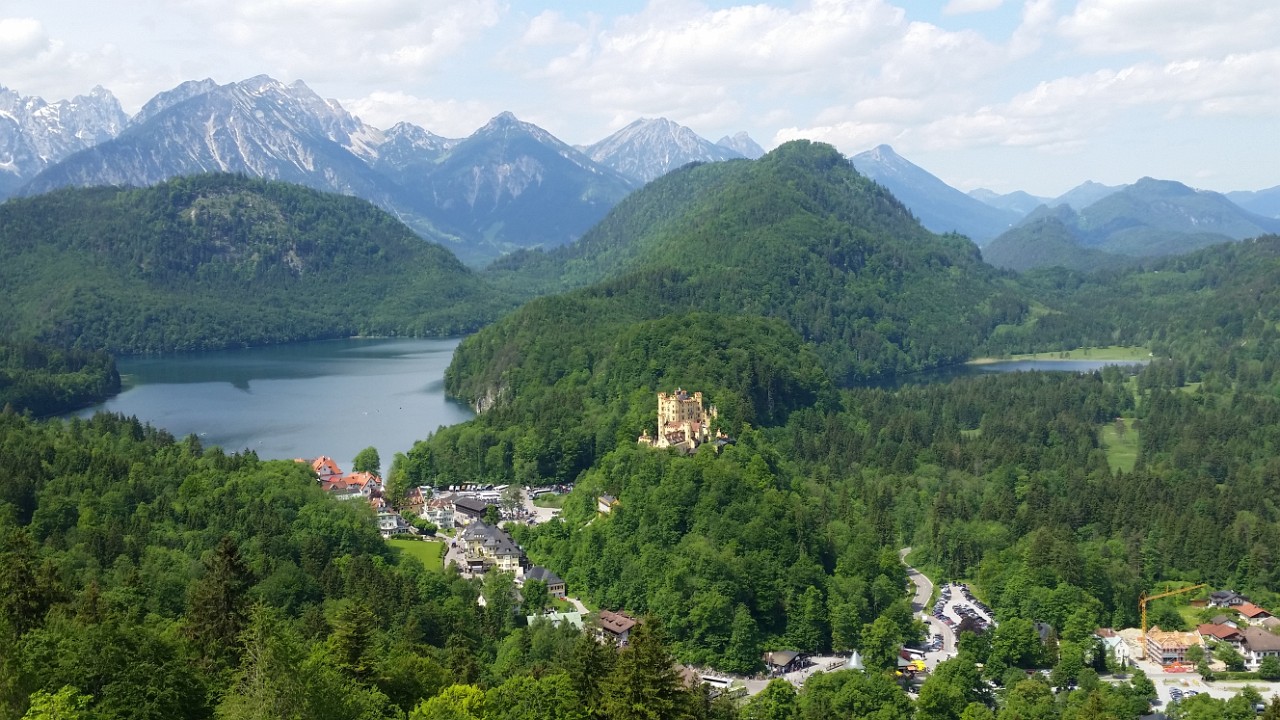
Hohenschwangau and the alps from the terrace at Neuschwanstein
The way out is down to the ground floor and through the historic kitchen which was equipped with the latest technology of the day.
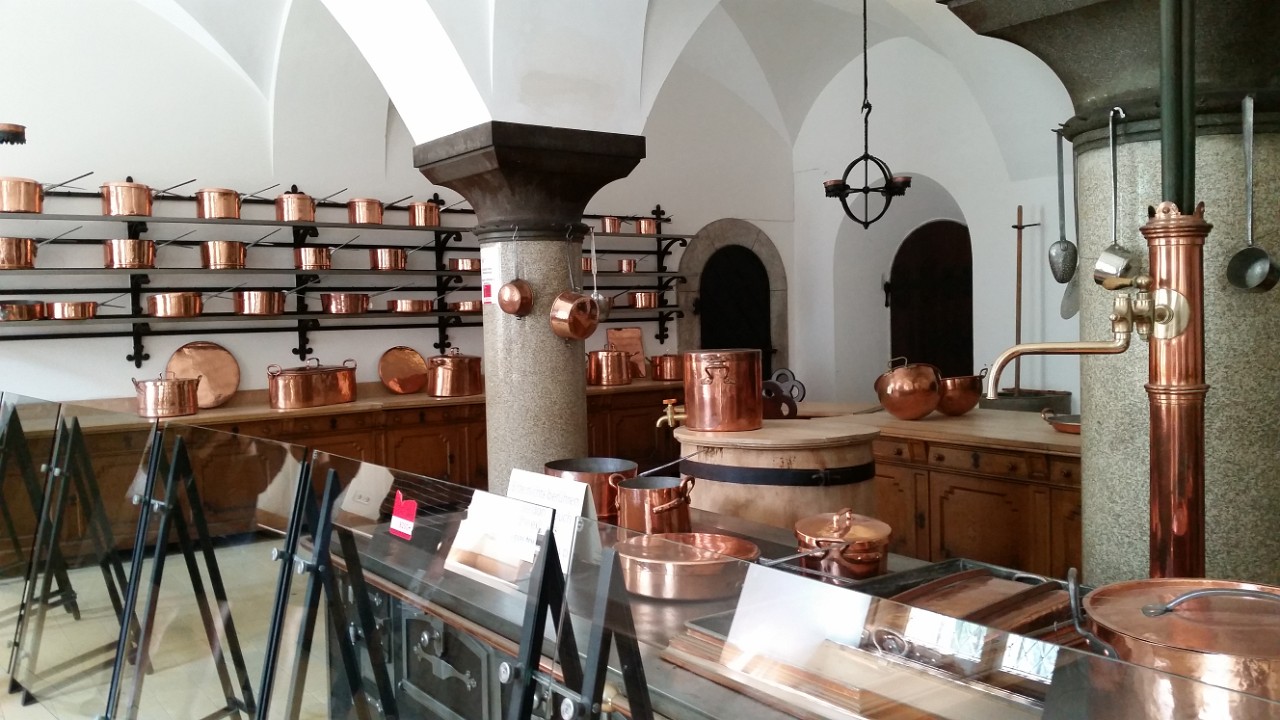
Neuschwanstein kitchen
The Marienbrücke (Queen Mary’s Bridge) spans the Pöllat gorge above Neuschwanstein, and a walk up the path to the bridge is a must for the perfect photo of this most famous of King Ludwig’s fantasy castles.
Marienbrucke (Queen Mary’s bridge)
From the Marienbrücke (Queen Mary’s bridge), King Ludwig admired his dream castle just like we do today. He didn’t get to live in this last fantasy castle of his too long though, while living there the Bavarian government certified him insane, deposed and ousted him from the castle. Days later he died mysteriously along with his psychiatrist in a lake near Munich. Just 7 weeks after his death, the reclusive fairy tale king’s fabulous castle was opened to the fascinated public.
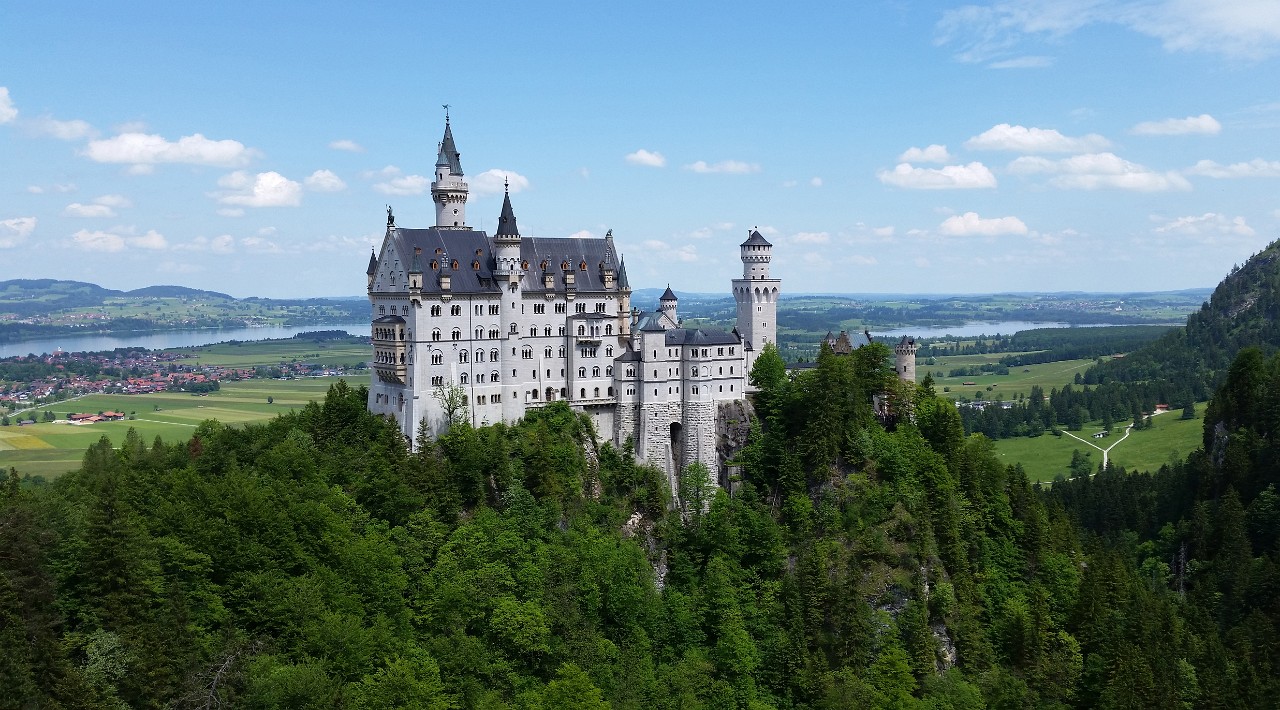
Neuschwanstein Castle from Marienbrucke (Queen Mary’s bridge)
Did you know? Walt Disney so admired this real life fairy tale castle he modeled his Fantasyland Sleeping Beauty Castle after Neuschwanstein.
Disneyland’s Sleeping Beauty Castle at night
Falkenstein Ruin
Fabulous 360° views of both Germany and Austria from the Falkenstein ruin. King Ludwig wanted to build a romantic castle here – he bought the ruin in 1883, had the road built, and had several architects working on the design but this location really was crazy, way too small for Ludwig’s vision.
Falkenstein Castle (Burg Falkenstein)
Falkenstein concepts
Design 1: Preliminary draft of the planned new building of 1883 by Christian Jank. This construction would not have been possible either in spatial or architectural terms.
Design 2: Reduced design by Goerg Von Dollmann in 1884. Ludwig II was so dissatisfied with this design that he immediately dismissed Dollmann.
Design 3: Reduced design by Max Schulze in 1884. This design would have been realized, since he came closest to Ludwig’s imagination of a robber-knights castle.
The one-way road takes awhile to get up – there’s a stop light at the bottom, when green you can go, when red someone is coming down the mountain. Before you go up the road, stop at the self-service toll machine at the bottom, put in 2€, take a ticket and put it on your dash.
Not far from Fussen, the ruin makes a great stop for an espresso at the outdoor terrace of the view restaurant just below the ruin.
Burghotel Falkenstein
It’s always fun to discover that you have a theme when you travel, and exploring these beautiful castles and locations and discovering the stories of King Ludwig II made a fantastic fairy tale theme for exploring this part of beautiful Bavaria.
King Ludwig II August 25 1845 – June 13 1886
